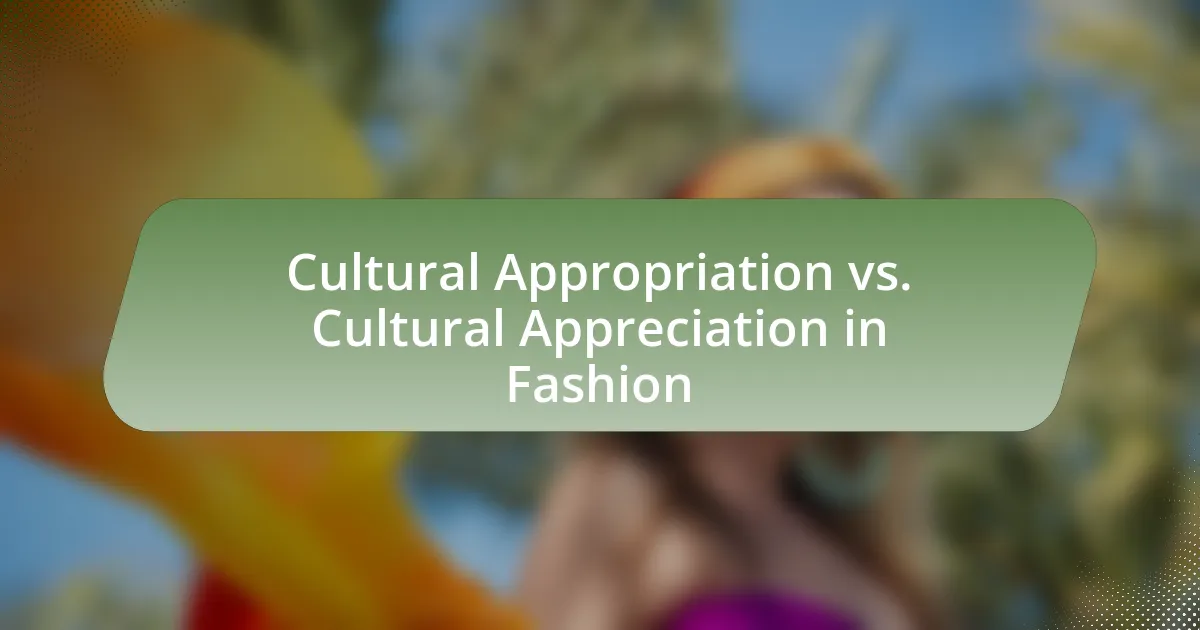Sustainable fashion is defined as clothing and accessories produced, consumed, and disposed of in environmentally friendly and socially responsible ways. The article explores the evolution of sustainable fashion from its origins in the 1960s and 1970s, influenced by countercultural movements and significant events like the Rana Plaza disaster, which highlighted ethical concerns in the industry. Key principles of sustainable fashion include ethical production, resource efficiency, and circularity, addressing both environmental and social implications. Current trends, challenges, and the role of technology in promoting sustainability are also examined, alongside practical steps consumers can take to support sustainable practices.

What is Sustainable Fashion and Why is it Important?
Sustainable fashion refers to clothing and accessories that are produced, consumed, and disposed of in ways that are environmentally friendly and socially responsible. This approach is important because the fashion industry is one of the largest polluters globally, contributing to significant waste, water usage, and carbon emissions. For instance, the United Nations estimates that the fashion industry accounts for about 10% of global carbon emissions and is responsible for the depletion of water resources, with the production of a single cotton t-shirt requiring approximately 2,700 liters of water. By prioritizing sustainable practices, the industry can reduce its environmental impact, promote ethical labor practices, and encourage consumers to make more conscious choices, ultimately leading to a more sustainable future.
How has the concept of sustainable fashion evolved over time?
The concept of sustainable fashion has evolved significantly from its origins in the 1960s and 1970s, when it primarily focused on ethical labor practices and environmental concerns. Initially, sustainable fashion was driven by countercultural movements advocating for eco-friendly materials and fair trade, as seen in the rise of brands like Patagonia in the 1970s, which emphasized environmental responsibility. Over the decades, the focus expanded to include not only the production processes but also the entire lifecycle of garments, leading to the adoption of circular economy principles in the 2000s. This shift was influenced by increasing awareness of the fashion industry’s environmental impact, with reports indicating that the industry accounts for about 10% of global carbon emissions. Today, sustainable fashion encompasses a broader range of practices, including the use of recycled materials, sustainable sourcing, and transparency in supply chains, reflecting a growing consumer demand for ethical and environmentally friendly products.
What historical events have influenced the rise of sustainable fashion?
The rise of sustainable fashion has been significantly influenced by several historical events, including the Industrial Revolution, the environmental movement of the 1960s and 1970s, and the 2013 Rana Plaza disaster. The Industrial Revolution marked a shift towards mass production, leading to increased waste and pollution, which prompted early awareness of environmental issues. The environmental movement, particularly the publication of Rachel Carson’s “Silent Spring” in 1962, raised public consciousness about ecological impacts, fostering a demand for more sustainable practices. The Rana Plaza disaster, where a garment factory collapsed in Bangladesh, killing over 1,100 workers, highlighted the ethical implications of fast fashion and spurred global calls for transparency and sustainability in the fashion industry. These events collectively catalyzed the transition towards sustainable fashion by emphasizing the need for ethical production and environmental responsibility.
How do cultural shifts impact sustainable fashion trends?
Cultural shifts significantly impact sustainable fashion trends by altering consumer values and behaviors towards environmental consciousness. As societies increasingly prioritize sustainability, fashion brands adapt by incorporating eco-friendly materials and ethical production practices. For instance, the rise of minimalism and the slow fashion movement reflects a cultural shift towards valuing quality over quantity, leading to increased demand for sustainable options. Research from the Global Fashion Agenda indicates that 66% of consumers are willing to pay more for sustainable brands, demonstrating a direct correlation between cultural values and purchasing decisions in fashion.
What are the key principles of sustainable fashion?
The key principles of sustainable fashion include ethical production, resource efficiency, and circularity. Ethical production emphasizes fair labor practices and humane working conditions, ensuring that workers are treated with respect and compensated fairly. Resource efficiency focuses on minimizing waste and utilizing sustainable materials, such as organic cotton or recycled fabrics, to reduce environmental impact. Circularity promotes the idea of designing products for longevity and recyclability, encouraging consumers to repair, reuse, and recycle garments rather than discarding them. These principles collectively aim to create a fashion industry that is environmentally responsible and socially equitable.
How does sustainable fashion address environmental concerns?
Sustainable fashion addresses environmental concerns by promoting eco-friendly materials, reducing waste, and encouraging ethical production practices. This approach minimizes the negative impact of the fashion industry on the environment, which is responsible for significant pollution and resource depletion. For instance, the use of organic cotton instead of conventional cotton reduces pesticide use by up to 90%, thereby protecting ecosystems and biodiversity. Additionally, sustainable fashion emphasizes recycling and upcycling, which can divert millions of tons of textile waste from landfills each year. By prioritizing these practices, sustainable fashion contributes to a more sustainable and responsible industry, ultimately leading to a reduction in carbon emissions and resource consumption.
What social implications does sustainable fashion encompass?
Sustainable fashion encompasses social implications such as improved labor conditions, community empowerment, and increased consumer awareness regarding ethical practices. Improved labor conditions arise from sustainable fashion brands prioritizing fair wages and safe working environments, which can be evidenced by organizations like Fair Trade that certify brands adhering to these standards. Community empowerment is fostered through local production initiatives that support artisans and small businesses, promoting economic stability in their regions. Additionally, increased consumer awareness is reflected in the growing demand for transparency in supply chains, as studies show that 66% of consumers are willing to pay more for sustainable brands, indicating a shift towards ethical consumption.

What Role Did the Fashion Industry Play in Sustainability?
The fashion industry has played a significant role in sustainability by increasingly adopting eco-friendly practices and materials. Over the past decade, many brands have shifted towards sustainable sourcing, reducing waste, and promoting ethical labor practices. For instance, the Global Fashion Agenda reported that the fashion industry is responsible for 10% of global carbon emissions, prompting initiatives like the Fashion Pact, which aims to align the industry with climate goals. Additionally, the rise of circular fashion, where products are designed for reuse and recycling, has gained traction, with companies like Stella McCartney leading the way in sustainable innovation. These efforts demonstrate the industry’s commitment to reducing its environmental impact and promoting sustainability.
How have major fashion movements contributed to sustainability?
Major fashion movements have significantly contributed to sustainability by promoting ethical practices, eco-friendly materials, and circular fashion concepts. For instance, the slow fashion movement emphasizes quality over quantity, encouraging consumers to invest in durable clothing rather than fast fashion, which leads to excessive waste. Additionally, the rise of eco-conscious brands, such as Stella McCartney, has popularized the use of organic and recycled materials, reducing the environmental impact of garment production. Furthermore, initiatives like Fashion Revolution advocate for transparency in supply chains, urging brands to disclose their manufacturing processes and labor practices, thereby fostering accountability and sustainability in the industry. These movements collectively drive a shift towards more responsible consumption and production patterns in fashion.
What impact did the counterculture movements of the 1960s and 1970s have on sustainable fashion?
The counterculture movements of the 1960s and 1970s significantly influenced sustainable fashion by promoting values of environmental consciousness, anti-consumerism, and social justice. These movements encouraged individuals to reject mass-produced clothing and embrace handmade, vintage, and second-hand garments, which aligned with sustainable practices. The rise of the hippie movement, for instance, emphasized natural materials and ethical production methods, leading to a greater awareness of the environmental impact of fashion. Additionally, events like Earth Day, first celebrated in 1970, galvanized public interest in ecological issues, further embedding sustainability into the fashion discourse. This cultural shift laid the groundwork for the modern sustainable fashion movement, highlighting the importance of ethical consumption and environmental stewardship in clothing choices.
How did the rise of fast fashion challenge sustainable practices?
The rise of fast fashion significantly challenged sustainable practices by promoting rapid production cycles and encouraging overconsumption. Fast fashion brands, such as Zara and H&M, produce clothing at an accelerated pace, often releasing new collections weekly, which leads to increased textile waste and environmental degradation. According to the Ellen MacArthur Foundation, the fashion industry is responsible for 10% of global carbon emissions and is the second-largest consumer of water, highlighting the unsustainable nature of fast fashion’s business model. This model prioritizes low-cost, high-volume production, undermining efforts to implement sustainable practices such as ethical sourcing and waste reduction.
What are the milestones in the history of sustainable fashion?
The milestones in the history of sustainable fashion include the establishment of the first eco-friendly clothing brands in the 1960s, the introduction of organic cotton in the 1990s, and the launch of the Global Organic Textile Standard in 2006. In the 1960s, brands like Patagonia began promoting environmentally conscious practices, setting a precedent for future sustainable initiatives. The 1990s saw a significant shift with the rise of organic cotton, which emphasized the reduction of harmful chemicals in textile production. The Global Organic Textile Standard, introduced in 2006, provided a comprehensive framework for sustainable textile production, ensuring transparency and accountability in the industry. These milestones collectively illustrate the evolution and growing importance of sustainability in fashion.
What initiatives have been launched to promote sustainable fashion?
Numerous initiatives have been launched to promote sustainable fashion, including the Fashion Revolution movement, which advocates for transparency in the fashion supply chain. This initiative encourages consumers to ask brands “Who made my clothes?” to raise awareness about ethical production practices. Additionally, the Sustainable Apparel Coalition, formed in 2011, brings together brands, retailers, and manufacturers to improve sustainability in the apparel and footwear industries through the Higg Index, a standardized measurement tool for environmental and social sustainability. Another significant initiative is the Global Fashion Agenda, which hosts the Copenhagen Fashion Summit, focusing on collaboration and innovation to drive sustainable practices in the industry. These initiatives collectively aim to reduce the environmental impact of fashion and promote ethical labor practices.
How have influential designers shaped the sustainable fashion landscape?
Influential designers have significantly shaped the sustainable fashion landscape by integrating eco-friendly practices and materials into their collections. For instance, Stella McCartney has been a pioneer in advocating for cruelty-free fashion, using organic cotton and recycled materials, which has set a standard for sustainability in high fashion. Similarly, Vivienne Westwood has emphasized the importance of ethical production and has campaigned against fast fashion, influencing both consumers and other designers to consider the environmental impact of their choices. These designers have not only raised awareness but have also demonstrated that sustainable fashion can be both stylish and commercially viable, thereby encouraging the industry to adopt more responsible practices.

What Current Trends Are Shaping the Future of Sustainable Fashion?
Current trends shaping the future of sustainable fashion include the rise of circular economy practices, increased use of eco-friendly materials, and the adoption of technology for transparency and traceability. Circular economy practices, such as recycling and upcycling, are gaining traction as brands aim to minimize waste and extend the lifecycle of garments. The use of eco-friendly materials, such as organic cotton and recycled polyester, is becoming more prevalent, with a report from the Global Fashion Agenda indicating that sustainable materials could account for 30% of the fashion market by 2030. Additionally, technology is enhancing transparency in supply chains, with blockchain being utilized to track the origin of materials, thereby fostering consumer trust and accountability.
How are technological advancements influencing sustainable fashion?
Technological advancements are significantly influencing sustainable fashion by enabling more efficient production processes, reducing waste, and promoting eco-friendly materials. Innovations such as 3D printing allow for on-demand manufacturing, which minimizes overproduction and excess inventory, while digital textile printing reduces water usage and chemical waste compared to traditional dyeing methods. Additionally, advancements in fabric technology, such as the development of biodegradable materials and recycled fibers, contribute to a circular economy in fashion. For instance, the use of recycled polyester from plastic bottles has been adopted by brands like Patagonia, demonstrating a practical application of technology in reducing environmental impact.
What role does innovation play in sustainable materials and production methods?
Innovation is crucial in developing sustainable materials and production methods, as it drives the creation of eco-friendly alternatives and efficient processes. For instance, advancements in biotechnology have led to the development of biodegradable fabrics, such as those derived from organic cotton or recycled polyester, which significantly reduce environmental impact compared to traditional materials. Additionally, innovative production techniques, like 3D printing and digital textile printing, minimize waste and energy consumption, aligning with sustainability goals. According to a report by McKinsey & Company, the fashion industry can reduce its greenhouse gas emissions by 30% through the adoption of innovative practices and materials. This evidence underscores the essential role of innovation in fostering sustainability within the fashion sector.
How are digital platforms changing consumer engagement with sustainable fashion?
Digital platforms are transforming consumer engagement with sustainable fashion by facilitating access to information, enabling community building, and promoting transparency. These platforms allow consumers to easily research brands’ sustainability practices, compare products, and share experiences, which enhances informed purchasing decisions. For instance, a 2021 survey by McKinsey & Company found that 67% of consumers consider sustainability when making fashion purchases, highlighting the influence of digital information on consumer behavior. Additionally, social media platforms like Instagram and TikTok have created communities around sustainable fashion, where users share tips, promote eco-friendly brands, and advocate for ethical practices, further driving consumer interest and engagement in sustainable fashion.
What challenges does sustainable fashion face today?
Sustainable fashion faces significant challenges today, including high production costs, consumer awareness, and supply chain transparency. High production costs arise from the use of eco-friendly materials and ethical labor practices, which can lead to higher retail prices compared to fast fashion alternatives. Consumer awareness remains a challenge as many shoppers prioritize affordability and convenience over sustainability, resulting in a lack of demand for sustainable options. Additionally, supply chain transparency is often limited, making it difficult for brands to verify and communicate their sustainability claims effectively. According to a 2021 McKinsey report, only 30% of consumers are willing to pay more for sustainable products, highlighting the need for increased education and engagement in the market.
How do economic factors impact the growth of sustainable fashion?
Economic factors significantly influence the growth of sustainable fashion by shaping consumer purchasing power and driving demand for eco-friendly products. For instance, as disposable income increases, consumers are more likely to invest in sustainable fashion brands that prioritize ethical production and environmental responsibility. Additionally, the rising costs of raw materials and labor in traditional fashion manufacturing push brands to adopt sustainable practices to maintain profitability. According to a report by McKinsey & Company, the global sustainable fashion market is projected to grow at a compound annual growth rate of 9.7% from 2020 to 2025, indicating a strong economic incentive for brands to shift towards sustainability.
What are the barriers to consumer adoption of sustainable fashion practices?
The barriers to consumer adoption of sustainable fashion practices include high costs, lack of awareness, and limited availability of sustainable options. High costs deter consumers as sustainable fashion items often come with a premium price tag, making them less accessible compared to fast fashion alternatives. Lack of awareness stems from insufficient education on the environmental impact of fashion and the benefits of sustainable choices, leading to consumer indifference. Limited availability refers to the scarcity of sustainable fashion brands in mainstream retail, which restricts consumer access to these products. According to a 2021 survey by McKinsey & Company, 66% of consumers expressed a willingness to pay more for sustainable products, yet only 27% reported having access to such options, highlighting the disconnect between consumer interest and market availability.
What practical steps can consumers take to support sustainable fashion?
Consumers can support sustainable fashion by choosing to buy from brands that prioritize ethical production practices and use eco-friendly materials. This choice encourages companies to adopt sustainable methods, as consumer demand drives market trends. Additionally, consumers can reduce their fashion footprint by purchasing second-hand clothing, which extends the life cycle of garments and minimizes waste. According to the Environmental Protection Agency, textile recycling can significantly reduce landfill waste, highlighting the importance of reusing clothing. Furthermore, consumers can educate themselves about sustainable practices and advocate for transparency in the fashion industry, pushing brands to disclose their supply chain information and environmental impact. By making informed choices and promoting sustainability, consumers play a crucial role in the shift towards a more responsible fashion industry.
How can individuals make more sustainable choices in their fashion purchases?
Individuals can make more sustainable choices in their fashion purchases by opting for brands that prioritize ethical production practices and use eco-friendly materials. Research indicates that the fashion industry is responsible for approximately 10% of global carbon emissions, highlighting the importance of conscious consumerism. By selecting clothing made from organic cotton, recycled materials, or sustainable fabrics like Tencel, individuals can significantly reduce their environmental impact. Additionally, supporting second-hand shops and clothing swaps can extend the lifecycle of garments, further promoting sustainability. According to a study by the Ellen MacArthur Foundation, extending the life of clothing by just nine months can reduce carbon, water, and waste footprints by around 20-30%.
What resources are available for learning about sustainable fashion practices?
Numerous resources are available for learning about sustainable fashion practices, including online courses, books, documentaries, and industry reports. Online platforms like Coursera and edX offer courses on sustainable fashion, such as “Sustainable Fashion” by the University of Copenhagen, which covers the environmental and social impacts of the fashion industry. Books like “Fashionopolis: The Price of Fast Fashion and the Future of Clothes” by Dana Thomas provide insights into the industry’s challenges and solutions. Documentaries such as “The True Cost” explore the consequences of fast fashion and promote awareness of sustainable alternatives. Additionally, reports from organizations like the Ellen MacArthur Foundation detail best practices and innovations in sustainable fashion, reinforcing the importance of these resources for education in this field.



